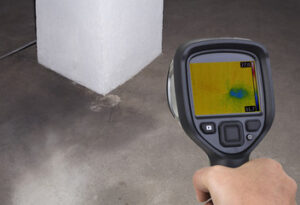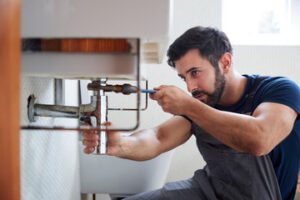A leak is a problem that will only get worse over time, so it’s important to identify the issue and have it repaired as soon as possible. Checking your water meter for sudden increases is a good start but if you cannot find the source of the problem, further investigations are necessary.

Acoustic Leak Detection is a cutting-edge technology that uses sound waves to identify and locate leaks. The premise is simple: when liquid or gas escapes from a pressurised system, it produces distinct acoustic signals that are not heard by the human ear. These sounds can be identified and analyzed with the help of sophisticated equipment and sensors. The acoustic detection technology can pinpoint the location of a leak in a short time, allowing for prompt repair and saving valuable resources that would otherwise be lost to irreparable damage.
Leaks can be a serious problem for any industrial or public water system, as they not only cause expensive damages but also result in significant financial losses due to water wastage. Acoustic water leak detection is a great solution for any facility that needs to find the source of a water leak quickly and easily. By analysing the sounds emitted by the system, the equipment can recognise any anomalies, such as hissing or whistling. Acoustic water leak detectors can even detect leaks in their earliest stages, which is beneficial because it allows operators to take appropriate actions before the damage worsens.
The advanced acoustic leak detection technology used in modern devices can identify the sound frequencies associated with specific types of pipe materials and diameters, as well as filter out background noise. The technology also enables technicians to determine the location of a leak by analyzing the timing of the signals received by different sensors. The use of sound analysis also reduces the need for manual inspection, saving time and reducing costs.
In addition, acoustic water leak detection can be combined with other technologies, such as pressure monitoring and thermal imaging, to improve accuracy and provide confirmation of the location of a leak. This can further reduce costs by eliminating the need for excavation and costly repairs.
The acoustic leak detection technology can be very useful in the oil and gas industry, as it can identify dangerous leaks of hazardous chemicals before they cause a fire or explosion. This can prevent disasters and ensure the safety of workers and the general public. Acoustic leak detection is also a crucial technology for water distribution systems, as it can identify and repair water leaks quickly and efficiently. This can save money by preventing costly repairs and water wastage, as well as minimise environmental impact and preserve natural resources.
LiDAR
Laser light can penetrate the surface of a body of water or air, creating a digital map of its elevation. This information can then be used to assess erosion, measure wildlife habitat and detect possible dangers. LiDAR technology can be mounted on drones or helicopters, delivering a bird’s eye view of an expansive area. Airborne LiDAR is commonly used in the oil and gas industry to scan for methane leaks at onshore facilities and large pipelines.
Depending on the type of sensor, LiDAR can produce 2D or 3D point clouds. 2D sensors send a series of laser pulses in one plane and measure the time it takes for each to return, offering distance information within that particular plane. This data is useful in industrial automation for basic obstacle detection and inventory management. It can also be used in archeology, mining and forestry for topographical mapping.
3D LiDAR uses multiple lasers or scanning mechanisms to send beams in both horizontal and vertical directions, generating a three-dimensional model of the environment. This data can be used to create detailed topographical maps, and it is often employed by autonomous vehicle AI applications for obstacle detection and navigation. It can also be used in forestry and archeology, in addition to urban planning and surveying.
In addition to its use in the oil and gas industry, LiDAR is a popular tool for forest canopy volume measurements and to monitor wildfires. It can also help with mine mapping and worker safety. The technology is also widely used in construction to create 3D models of terrain and infrastructure.
When a methane leak occurs, GPS coordinates logged by LiDAR can be used to pinpoint the source of the emissions. This allows natural gas companies to quickly identify a leak and respond accordingly, saving the company money and avoiding costly negative publicity. The technology can be deployed in a fraction of the time it would take to visit each site manually. It is especially useful in remote areas where crews have limited line of sight. In these cases, it can be a lifesaver for both worker and the public.
Drones
A drone is any unmanned aerial vehicle (UAV) that can be controlled remotely and fly at varying distances and heights. They are used for a variety of tasks, including surveillance, military operations, agriculture, building inspection, and surveying. Drones are available in a variety of shapes, sizes, and designs and can be equipped with a wide array of sensors for different applications.
A popular use of a drone is for the search and rescue of people in disasters or after terrorist attacks. The drone’s remote control allows it to access areas that would be difficult or dangerous to get into on foot, helping with the search for survivors, delivering supplies to victims, and documenting damage for insurance claims.
Using a drone for pipeline leak detection can help reduce the cost of repairs and minimize environmental impact. The technology is relatively inexpensive and provides a much higher level of accuracy than traditional methods. Drones can also provide a more detailed picture of a site than traditional cameras, which means that they can identify leaking pipes and even determine the type and location of a leak.
Leak noise correlators are specialized devices that can be attached to a drone to detect vibrations in water lines and find the source of the leak. These are often used in conjunction with other testing equipment to pinpoint the location of a leak.
Drones are increasingly being employed in infrastructure construction projects to enhance safety, speed up data collection and improve documentation, resulting in cost savings and better project outcomes. Drone-based infrastructure inspection can also help reduce the number of personnel needed for a task by providing high-definition images that eliminate the need for manual inspections or expensive ground or air vehicles.
A drone can be equipped with a range of sensors, including ultrasonic, laser or lidar distance sensors, chemical or heat-signature detectors, and accelererometers, gyroscopes, magnetometers, and barometers. They can also carry a camera to capture still or video images. In the military, drones are often armed with weapons or explosives for surveillance and attack missions. They can be adapted for different purposes by attaching various modules, such as radar, infrared, and optical cameras.
Thermal Imaging
In the field of thermal imaging (also known as IR) technology, sensors detect the infrared radiation emitted by objects and display it on a screen. These devices are useful for a variety of applications, including gas leak detection and building inspections. They can also help prevent equipment failures and enhance safety in industrial environments. Thermography is also useful for monitoring physiological activities, such as fever and disease, in human beings and other red-blooded animals. This allows for improved patient care and better control at borders in the event of a contagious outbreak.
In addition to being used in military applications, thermal imaging cameras are widely used in civilian life. These sensors can easily detect intruders lurking around a home, as they can spot the human body’s heat signature even in pitch-black darkness. They are a great tool for security applications, especially when paired with motion sensors.
Unlike active IR systems, which use short wavelength infrared to illuminate the scene of interest, thermal imagers use mid to far-infrared energy. This means they can only sense differences in heat, and are not affected by reflected light such as from the sun, incoming headlights, smoke, haze or dust. As a result, thermal cameras can be used in a wide variety of challenging environments, and are often deployed in harsh conditions such as underground mining, explosive gases, and extreme weather.
Thermal images can be used to pinpoint hot spots, a critical factor in determining the cause of fires. They are also a valuable aid in finding people trapped inside buildings. They can be used to monitor water level in tanks, improve quality control processes in manufacturing, and to ensure that equipment is operating correctly.
While thermal imagers can see through most objects, they cannot see through walls. To overcome this limitation, a standard material of known emissivity can be applied to the object. This could be as complex as an industrial emissivity spray produced specifically for this purpose, or as simple as standard black insulation tape. The emissivity of the object is then measured, and the imager can calibrate to this value.

